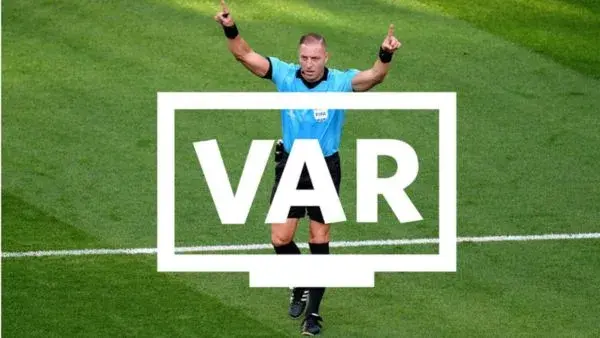Take the football rules quiz below and find out if you'd be a good referee during a football match.
Adverts
Football is one of the most popular sports on the planet, attracting millions of fans and players in stadiums and fields around the world.
Its global appeal is due as much to the simplicity of the game as to the thrill it gives spectators. However, for the game to remain fair and competitive, it follows a set of clear and well-defined rules.
These standards are developed and updated by the International Football Association Board (IFAB) and FIFA with the aim of guaranteeing the integrity and dynamism of matches.
Adverts
Each rule covers specific aspects of the sport, from the duration of matches to how to proceed in the event of offences and punishments. The responsibility for applying the rules on the pitch lies with the referees, who need to be fully conversant with these guidelines!
Although regular fans are already familiar with most of the rules, some points may seem complex to those who don't follow the sport closely. Read on to get a better understanding of the rules and test your knowledge:
Quick Index:
History of Football Rules
The rules of football that we know today were formally established for the first time in 1863 in England, with the foundation of The Football Association.
Before that, several versions of the game existed, each with its own peculiarities and regulations.
The standardisation of these rules was fundamental to the development of the sport as we know it. Back then, some matches were much more violent and lacked central organisation.
With formalisation, football began to gain popularity and spread to other continents.
Over the decades, the rules have undergone many changes. For example, the offside rule has gone through many revisions, with different definitions of how and when a player would be in an offside position.
The inclusion of specific rules, such as cards for offences and criteria for substitutions, has also evolved to make the game more dynamic and safer.

The History of Football
Do you know how football came about? Discover the history of the world's most famous sport and learn about the main championships.
Continue reading →The role of FIFA and IFAB
FIFA, founded in 1904, is the world's leading football authority. However, the IFAB, made up of the UK associations and FIFA itself, is the body responsible for creating and updating the rules of the game.
This arrangement ensures that the rules are applied consistently, while respecting the traditions and evolution of football.
One of the IFAB's most important functions is to review and implement new technologies in sport.
The use of VAR and the introduction of revisions to the rules relating to penalties, playing time and player behaviour are intended to modernise football while preserving its essence.
The balance between innovation and tradition is a constant challenge for regulators.
Fundamental Rules of Football
Do you know the main rules in football? Read on and find out:

Game duration
A regular match is divided into two 45-minute halves, with a 15-minute break. If the score is level and a winner is needed, two extra 15-minute halves are played, followed, if necessary, by a penalty shoot-out.
During regulation time, the referee can add extra minutes, known as added time, to compensate for stoppages in play due to substitutions, injuries or other events.
Field dimensions and equipment
The pitch must be between 90 and 120 metres long and 45 to 90 metres wide. Each player must wear a shirt, shorts, socks, shin pads and boots.
Goalkeepers wear different uniforms to make them easier to identify, and in some leagues, the use of specific numbers for each position is also compulsory.
Number of players and substitutions
Each team must start with 11 players, including the goalkeeper. If a team has fewer than 7 players due to injury or expulsion, the match is stopped.
In official tournaments, up to five substitutions are allowed, spread over three breaks so as not to affect the pace of the game. In tournaments with more flexible rules, some teams use a larger bench, especially to protect players from injury.
Game Start and Restart
The game begins with a kick-off in the centre of the pitch and is restarted in the same way after a goal. To reposition the ball on the pitch, goal kicks, corner kicks or side kicks are used, depending on the situation.
Each restart has its own specifics, such as who should touch the ball and in which direction.
Fouls and penalties
Fouls can be direct or indirect, depending on their severity. Direct fouls allow a direct shot on goal, while indirect fouls require the ball to touch another player before entering the goal.
The referee can also give yellow or red cards, depending on the seriousness of the offence. Two yellow cards result in a red card, and the team is down a player.
Impediment
A player is considered offside if he is in front of the penultimate defender at the time of the pass. The offside rule is one of the most complex and debated in football.
It's important to remember that an offside position is not an offence in itself, but rather when the player actively participates in the play.
Curiosities about the rules of football
- The first offside rule required three opposing players to be in front of the striker for him not to be considered offside.
- Until 1970, yellow and red cards didn't exist; referees only signalled offences with verbal warnings.
- The use of VAR is only permitted in four situations: to check goals, penalties, red cards and mistaken identity.
The VAR (Video Assistant Referee)
VAR (Video Assistant Referee) is one of the most significant technological innovations introduced into football in recent decades. Its main purpose is to support the main referee in critical situations and correct obvious errors that could alter the outcome of a match.

The technology was officially adopted by FIFA in 2018 during the World Cup and quickly became an essential part of the game in international competitions and elite leagues.
The VAR system is made up of a team of assistant referees who analyse moves in real time from a control room equipped with monitors showing different angles of the pitch. The VAR referees have the task of reviewing four types of situations:
- Goals and situations involving the legality of the goal
Check for any offence in the play that led to the goal, such as offside, a foul or a handball, ensuring that the goal is validated correctly. - Penalty decisions
Analyse whether a foul inside the penalty area has been called correctly, whether there has been sufficient contact to justify the penalty or whether there has been simulation on the part of the attacker. - Direct red cards
Reviewing moves that could justify a red card for violent conduct or unsportsmanlike behaviour. Yellow cards are not reviewable by the VAR. - Identity mistake
Correct situations in which the referee sends off or warns the wrong player, ensuring that sanctions are applied fairly.
During a review, the main referee can interrupt the game and consult the VAR via a monitor on the side of the pitch, making the final decision after analysing the images. Although VAR has helped reduce many obvious errors, it has also brought challenges.
The biggest criticism has to do with the impact on the pace of the game, as revisions can take several minutes, disrupting the fluidity of the game.
In addition, interpretations of tackles and offences are still a matter of debate, since VAR only provides visual support, but the final decision still depends on human judgement.
Despite the criticism, VAR represents an important step towards promoting greater fairness and accuracy in football, reducing errors that could change the outcome of competitions and helping to protect the integrity of the sport.
How to Become a Football Referee
To become a football referee, you need to complete a refereeing course that includes theoretical and practical lessons on the rules of the game, refereeing techniques and emotional control.
After certification, new referees usually start out in amateur matches, gaining experience and moving up the ranks over time. Career progression depends on performance and the ability to manage matches under pressure.

In addition, it is essential to maintain good physical fitness, as the referees need to keep up with the pace of the players during the 90 minutes.
They must also continually update themselves on changes to the rules and take part in workshops and training sessions. With experience and dedication, it is possible to reach high-level competitions and even international events.
Conclusion
Understanding the rules of football is fundamental for anyone who wants to have a more in-depth view of the sport. They ensure that matches are played fairly and intensely, promoting a balanced and competitive environment. When you know the rules, you come to appreciate every detail of the matches even more, making the experience richer and more exciting.
Do you want to know if you have the profile to be a referee? Take our quiz and put your knowledge to the test!!!











